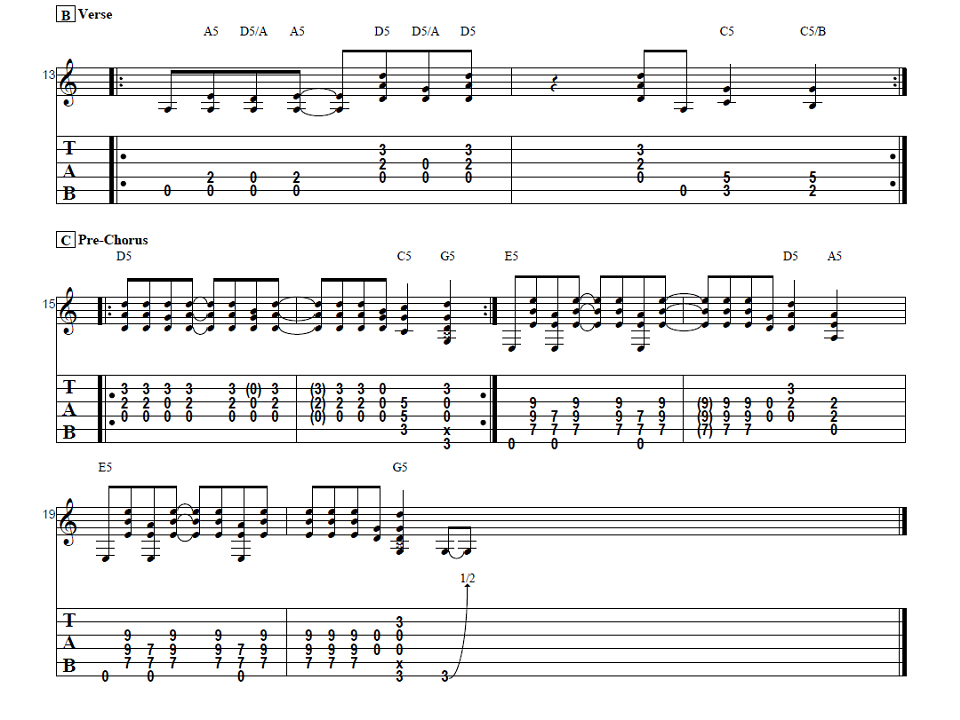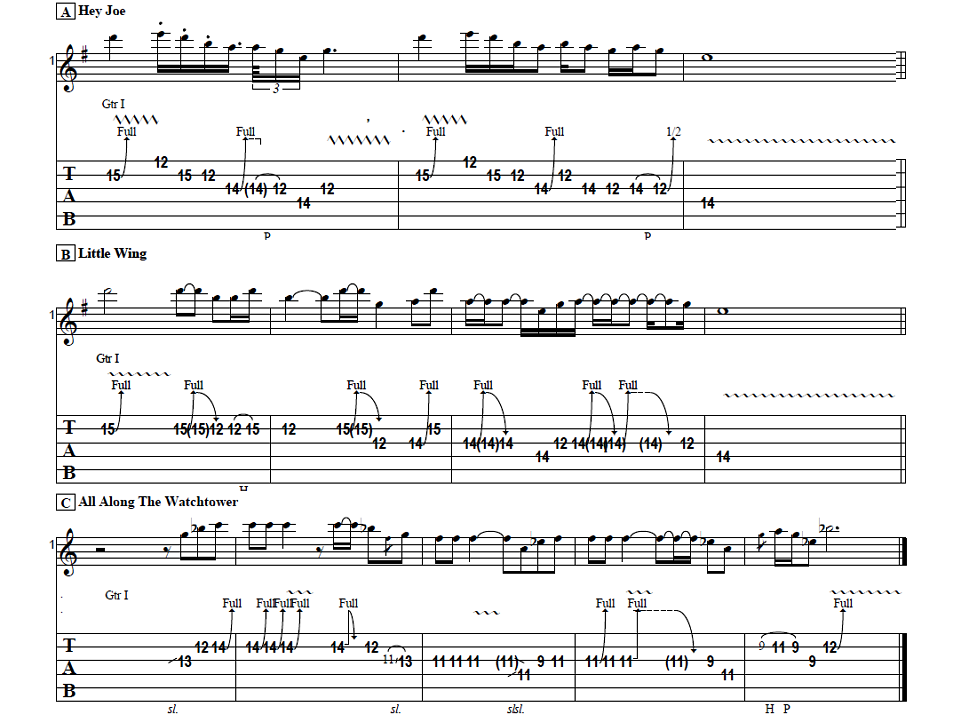Learn to play the classic Hell’s Bells by AC/DC from Guitar Control instructor Darrin Goodman. Heads will turn when you bust out this classic at the next jam session. Be sure to get the free tabs to go along with this killer lesson.


Introduction
Hey everybody how’s it going? This is Darrin with GuitarControl.com bringing you this video lesson. Today I want to show you that all the different parts to play Hell’s Bells by AC/DC. This is a really cool riff and every time I hear it just gets me pumped like when I’m driving, dangerous song to be driving to. So anyhow be sure to click on the link in the description for the tabs and let’s get close up and take a look.
Hell’s Bells Main Riff
All right so first we’ve got this riff that’s it’s kind of the main riff of the song; it’s in the intro and it’s also in the chorus. So starting off here we have an A5 power chord; so I’ve got my first finger on the seventh fret of the D string and my third finger on the ninth fret of the G string. So starting off we play the open A string and then to the G string and then to the D string… then you’re going to take your first finger and you’re just going to barre it so you’re picking up the seventh fret of the D and the G string and then you just hit the G and D string and then follow that with the open A string again. Then you’re going to take your first finger and you’re going to move it down a whole step so now we’re barring the fifth fret of the G and D string, same thing again, the G string and then the D string and then the A string open… Then we just move right back up to the where we were before so we’re barring the seventh fret and you hit the open A string twice and that’s the first two measures… Okay and then starting on the third measure it’s kind of the same thing again… then the second time when we come back up to the seventh fret we just hit just the G string and then we’re going to come down here and we’ve got a C5 power chord; so my first finger is on the third fret of the A string and then usually I would use my third finger, but I use my fourth and I’ll explain why. So I’m using my first finger here on the third fret of the A string and my fourth finger on the fifth fret of the D string, so that’s C5, we’re going to take the note here on the A string and we’re going to move it down to the second fret but keep the one here on the D string on the fifth fret and that’s C five over B (C5/B) and then we follow that with the open A string again… so that’s basically that whole riff… So for the intro it goes through it like four times I think and then the whole rest of the band comes in and then it’s got this kind of a little bit of a different part at the end of it and the last time through is like this… we go to a G5, so if you just take your regular open G chord and your second finger you kind of let it droop forward a little bit so it’s muting the A string so we’re just getting the third fret of the low E string, the A string is muted, the B and G strings are open and then we’re on the third fret of the B string with my third finger and the third fret of the high E string with my fourth finger and we hit that twice and then we hit the A and D strings open and then D5. So if you just take your regular open D chord, but you don’t want to get the note that’s on the high E because that’s actually your third; so here it’s just like a fifth. Now if you do it and you get that note it’s not a big deal; one we’re only there for a second and two it’s part of the triad if we were playing the full chord anyway. So you have and then we go to the third fret of the A string with my second finger and we’re gonna pick that and just put a slight bend on it to the second fret and then open. So that’s like the end of the intro… then we go into the next part. So we’re still using the same chords that we did before, but now we’ve got… so how I do it is I just barre my first finger here to begin with on the seventh fret of the D and G strings and then just use my third finger to come here to the ninth fret of the G string. So we’ve got seven and nine, so this is like A5 and then D5 and I’m going to go through and just call them the chords back and forth constantly because they’re just kind of weird ones. So if you think of it like your third finger goes on and off and then we come down to the fifth fret and do… and then back to the seven and then the open A and then that C5 and C5/B… and then repeat that… and then that’s the end of the intro and then that leads us into the verse.
Verse
Now for the verse, it’s actually very similar to the intro, we’re just going to be playing it in a different place. So here we’re going to come down and put your first finger onto the second fret of the D string and do like an A5. So we start off with the open A string and then we just play the A and D strings open and then back and then we come to that D5 we did before and then the open D and G strings… and back to the D5; so that’s the first measure. Then the downbeat of one, actually the whole first beat of the next measure is at rest; so this is like one and two and three and four and one and then we do that D5 again on the downbeat of two and then the end of two is the open A string and then for beats three and four it’s C5 and C5/B and then that just repeats… and that’s the verse and it just keeps repeating that whole time through the verse, I think it’s a total of eight times. So after that it goes into the pre-chorus.
Pre-Chorus
So we come back up to that D5 and you’ve got one and two and the and of two is tied to the downbeat of three; so you got one and two and three and four and, so on the downbeat of four it’s just the open D, G and B strings… And then the this is on the downbeat of end of four and then that’s tied to the downbeat of one on the next measure… So on the end of two of the second measure you hit the open strings again and then we go with C5 and then the G5 and then that whole thing repeats… Now we’re going to shift up so now we’ve got an E5 power chord up here; so my first fingers on the seventh fret of the A string, third finger is picking up the ninth fret of the D and G strings and we’ve got the open low E string on the downbeat of one, one and, two and, three and… and then on the downbeat of two it’s just barring the seventh fret of the A and D strings; so kind of do this like we did on that beginning, but we’re just doing it a set of strings lower… then the open D and G strings, that’s on the end of two of the next measure, so one and, two and, three and, four and, one and, two and, then D5 to A5… so that’s the first two measures of that. Measure 19 is starts off the same way and this time when we hit the open D and G strings we go straight to the G5 and then we bend that it’s just a little bit on the third fret of the low E string or excuse me and then that’s where it goes right back into the chorus… Then it goes into the chorus and the chorus is just like that beginning… So as you can see that it’s not really too terribly hard, but it’s such a cool sounding riff. I really like the stuff that Malcolm Young did with chords, it just really gave AC/DC this kind of distinct sound with that kind of stuff.
Conclusion
All right so there you have it. That’s all the parts to Hell’s Bells by AC/DC. Like I said not too terribly tough to play, but it’s a it’s a really cool riff that’s fun to play and very recognizable; everybody knows this one. So if you like this lesson be sure to give me a thumbs up and leave a comment down below if you have any questions or comments about this or other guitar related subjects. If you have not already done so please hit that subscribe button and click the notification bell so you don’t miss any of the content that we upload throughout the week. Well that is all I have for you today. Thanks for watching How To Play Hell’s Bells By AC/DC and have a great day.


